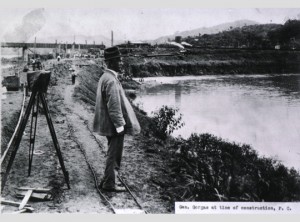The Canton Asylum for Insane Indians had its share of investigations, which often were a result of staff complaints. It was not unique in this respect–other asylums were also investigated with regularity, sometimes because of staff complaints, but often through outside intervention. In 1906, the Medico-Legal Society of the District of Columbia made a number of spectacular charges against the Government Hospital for the Insane (St. Elizabeths). The charges included allegations of brutal restraint through the use of “toweling” and the “saddle,” as well as “kicking and cuffing by attendants.”
Toweling involved placing dry towels around a patient’s neck and twisting from behind, to physically subdue a patient who was out of control. The allegations included a charge that the towels were twisted until the patient fell over semi-conscious. The saddle was a device which held patients in a reclining position, bound hand, foot, and neck, so that they couldn’t move at all; many were supposedly left for hours in this condition.
Patients were abused this way for their failure to obey orders or to do work properly, or for “taking an extra spoonful of beans” at table. Additionally, attendants were charged with using the feeding tube (which was pushed down through to nostril to feed patients who would not willingly eat on their own) as a punishment.
The charges were sensational, but were they true? St. Elizabeths’s board of visitors (its oversight group) asked the Medico-Legal society to help them investigate the charges they had made, but the group refused to appear before them or to submit its records concerning the abuse.
My next few posts will continue to discuss this investigation.





